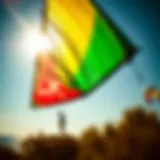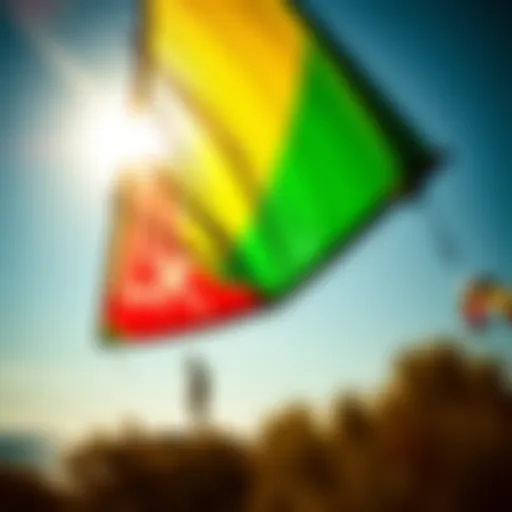The Wing Board: A Deep Dive into Kiteboarding Gear
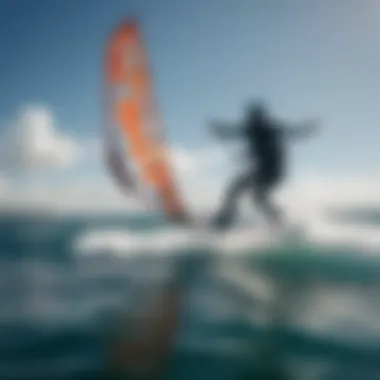

Intro
The world of kiteboarding has been spinning its wheels for years, but the introduction of wing boards is like pouring fresh fuel into an old engine. These boards are not just a passing trend; they represent a whole new way of navigating water while harnessing the wind. If you've ever wanted to feel like you're flying over the waves, wing boards might just be your ticket to that experience.
Wing boards combine elements of kitesurfing and stand-up paddleboarding, offering a unique blend of thrill and versatility. As you explore this article, you’ll find a treasure trove of insights—from the nitty-gritty of design to the whizz-bang technology that has come to define this sport. Whether you’re looking to dip your toes into the water for the first time or you’re a seasoned pro hoping to take your skills up a notch, there’s something here for everyone.
We’ll cover essential gear, tips, and safety precautions, ensuring you’re well-armed for your adventures. Plus, we’ll take a look at how wing boards are impacting the broader kiteboarding scene. Trust me, this isn't just another gadget; it's a game-changer in how enthusiasts approach their craft. Let's dive in!
Preamble to Wing Boards
The evolution of water sports continues to stir excitement among enthusiasts, with the emergence of wing boards being a pivotal development. Understanding wing boards is essential for anyone interested in kiteboarding, as they represent a fusion of innovation and practicality in aquatic recreation. With this introduction, we’ll unravel the significance of wing boards, touching on their design attributes and the multifaceted appeal they hold for various types of riders.
Defining the Wing Board
At the core of this discussion is defining what a wing board actually is. In its simplest terms, a wing board is a specialized piece of equipment used in kiteboarding that allows riders to harness wind power in a unique way. Unlike traditional boards, wing boards separate the rider from the water’s surface, which enhances lift and speeds up the gliding experience. They typically feature a wide, flat design, which supports balanced riding and allows for more effortless take-offs.
The design integrates an inflatable wing that attaches via a boom, looked like a small kite, enabling riders to adjust their position and optimize performance. This versatility makes the wing board suitable for both novice kiteboarders looking to get their feet wet and experienced riders looking to push their limits in terms of tricks and jumps.
Historical Development
To fully appreciate the wing board, one must delve into its historical context. The roots of wing boards can be traced back to the early 2000s, but the concept itself stems from a blend of various board sports. Kiteboarding saw a significant surge in popularity during the late '90s, which led innovators to explore new designs and functionalities.
By 2010, the first commercially viable wing boards began hitting the market, featuring advanced materials that improved durability and buoyancy. One notable moment in its development was when companies like Duotone and Slingshot started experimenting with different shapes and sizes, leading to a surge in popularity.
"The evolution of wing boards has been like watching a child grow up; each refinement brings newfound capabilities."
These boards gained traction among professional riders who sought a fresh challenge in the sport, appearing at international competitions and showcasing unique performance capabilities. Riders began to note the advantages of wing boards, such as their ability to catch lighter winds, making them accommodating for varying conditions.
Today, wing boards have carved out a distinct identity in the kiteboarding community. They're not merely an accessory; they represent a noteworthy advancement in riding technique and style. Understanding the progression from initial designs to modern applications is crucial for enthusiasts eager to grasp the future landscape of water sports.
Design Characteristics
The design characteristics of wing boards are essential elements that dictate not just performance but also user experience. Understanding these features can help riders make informed choices that align with their skill level and riding style. This section will dissect the critical aspects of wing board design, aiming to provide a clear picture of why these elements matter to kiteboarders, instructors, and enthusiasts alike.
Materials Used
At the very core of any wing board's performance lies its construction materials. The choice of materials has a direct impact on the board’s buoyancy, flexibility, and overall durability. Common materials include fiberglass, carbon fiber, and various foams.
- Fiberglass offers a balance between weight and strength, making it a popular choice for many entry-level boards. Its relatively lower price point doesn't compromise too much on performance, especially for beginners.
- Carbon fiber, while more expensive, is renowned for its lightweight properties and superior stiffness, allowing advanced riders to experience better control and responsiveness on the water.
- Foams are used for the core of the board, as they provide buoyancy, helping the rider get up on the water faster. The density of the foam can influence how the board reacts to waves and choppy conditions.
Choosing the right material can feel like splitting hairs for some, but getting it right is crucial for achieving that sweet spot between performance and comfort.
Shape and Size Variations
The shape and size of wing boards are another vital piece in the puzzle of effective kiteboarding. Generally speaking, shape refers to the outline of the board, while size relates to dimensions, particularly length and width. Understanding these variations can vastly affect stability and maneuverability on the water.
- Wider boards often provide more surface area, which translates to increased stability. This can be particularly beneficial for newcomers who may still be finding their sea legs.
- On the flip side, narrower boards can excel in speed and responsiveness, allowing seasoned riders to perform sharp turns and tricks.
- Board length also plays a key role. Longer boards can offer smoother rides over choppy water, while shorter boards allow for more agility and speed.
Many riders often find themselves pondering the right size and shape suited for their own unique style. It’s like finding a favorite shoe – personal comfort level plays a huge role in performance.
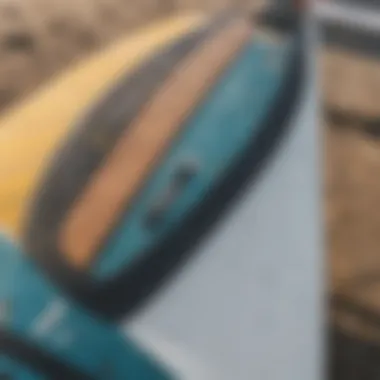

Comparative Analysis with Traditional Boards
When comparing wing boards to traditional kiteboards, distinct differences emerge that are worth examining.
One clear advantage of wing boards is their ability to harness wind power for lift, providing a different experience altogether. With traditional boards, momentum often relies more heavily on kite movement and rider technique. In contrast, wing boards allow for a more dynamic interplay between the rider and the wing.
- Maneuverability with wing boards tends to outshine traditional boards, particularly in lighter winds, thanks to the lift they generate. Riders can turn with a flick of the wrist.
- Learning curve can often be steeper with traditional kiteboards, while wing boards allow for a more intuitive sense of balance and control, appealing to those just starting out.
As with all comparisons, the best choice comes down to individual preferences. Those who enjoy variety, speed, and a bit of adventure might find wing boards a thrilling alternative to traditional kiteboarding gear.
"Adapting to a new board type is as much about understanding your own body as it is about the board itself. It requires patience and practice."
In wrapping up this section, it becomes clear that design characteristics define not just performance but also a rider's overall enjoyment and potential skill growth in kiteboarding. Every feature, even down to the choice of materials, plays a pivotal role in shaping the ultimate kiteboarding experience.
Technical Aspects
When discussing wing boards, one cannot overlook the pivotal role that technical aspects play in enhancing both performance and user experience. These elements lay the groundwork for understanding how wing boards operate effectively on the water, transforming enjoyable recreation into a finely tuned sport. Technical knowledge is essential for those who wish to push their limits, whether they are just beginning their journey or are veterans on the waves.
Hydrodynamic Principles
Hydrodynamics, the science of fluids in motion, is a core principle that informs the design and functionality of wing boards. Understanding these principles is crucial for achieving optimal performance. At the heart of it, the wing board's design is tailored to minimize drag while maximizing lift. This concept is particularly significant in kiteboarding, where the rider's ability to harness wind energy and convert it into propulsion is influenced by the board’s shape and features.
- Lift and Drag: Lift is created due to the difference in air pressure above and below the wing surface as it moves through the water. Conversely, drag is the resistance opposing the motion of the board. A well-designed wing board seeks to achieve a balance between these two forces. This balance can mean the difference between a smooth ride and a frustrating struggle against the elements.
- Flow Dynamics: The board's streamlined profile allows for a smoother flow of water around it, which aids in fludity and speed. This fluid motion is critical during maneuvers, where quick directional changes are necessary. Riders often find that their performance greatly improves when they select boards that are designed with these hydrodynamic principles in mind.
Let’s not forget the slight tweaks that can make all the difference. A minor adjustment to a board’s rocker or thickness can significantly impact how it rides. Therefore, riders should prioritize understanding these principles to not only choose the right board but also to enhance their riding techniques.
Performance Metrics
Assessing the performance of a wing board goes beyond simply looking at speed. Various metrics are crucial for understanding how well a board performs in different conditions.
- Speed: The primary metric for many kiteboarders is, of course, speed. It determines how quickly you can travel across the water, but achieving higher speeds involves understanding the relationship between wind power and board design.
- Stability: A stable board allows for more control, particularly during challenging conditions. Factors that affect stability include the board's width, weight distribution, and overall construction. Riders should assess how different boards feel under their feet when tackling waves or gusty winds.
- Maneuverability: This refers to how easily a board can turn or change direction. It's closely related to shape and size; a shorter board may offer more agility, while a longer one might favor speed over swift turns. It’s a trade-off riders must consider based on their style.
These performance metrics offer a straightforward way to gauge which wing boards suit different riding styles. In the world of kiteboarding, where conditions can shift in the blink of an eye, having the right board can be paramount to success.
Advancements in Wing Technology
The evolution of wing boards is marked by the relentless pursuit of innovation. Recent advancements in materials and design strategies have greatly enhanced performance and safety.
- Material Innovations: The introduction of lighter materials such as carbon fiber has transformed wing boards, allowing for greater buoyancy without compromising strength. This not only improves performance but also makes handling easier.
- Smart Technology: With the integration of smart technologies in some boards, features like adjustable wings and responsive flex characteristics are now available. These boards can adapt to different conditions, offering a customizable experience for users.
- Eco-conscious Designs: Recently, there’s been a push towards sustainable materials in production. This trend aims to minimize environmental impact while still delivering high-performance gear.
As riders become more advanced, they will demand even more from their equipment. Future developments, particularly in electric propulsion and AI-driven designs, could reshape kiteboarding standards entirely.
"The future of wing boards hinges not just on performance, but also on how riders can engage with the environment responsibly and innovatively."
By embracing the technical aspects presented here, kiteboarding enthusiasts will not only enhance their own experiences but also contribute to a vibrant and evolving community.
Applications in Kiteboarding
The world of kiteboarding is constantly evolving, and wing boards have emerged as a significant player in this arena. These innovative boards offer unique advantages that enhance the kiteboarding experience, making them essential for both beginners and seasoned riders alike. Utilizing a wing board on the water not only opens up a range of new riding options but also contributes to the overall thrill of the sport.
Use Cases for Beginners
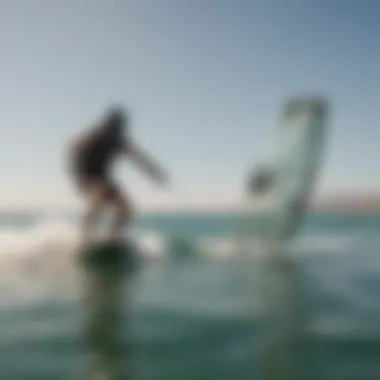

For newcomers to kiteboarding, wing boards present a fantastic opportunity. They are generally designed to be stable and user-friendly, making initial experiences on the water less daunting. When a beginner mounts a wing board, they often find it easier to pick up speed and maneuver through the waves. The larger surface area typically provides increased buoyancy, which can help in balancing and maintaining control.
Typically, beginners are introduced to wing boards in a few distinct scenarios:
- Learning to Balance: The added stability helps riders gain confidence.
- Early Speed Development: Gliding along the water becomes easier, allowing for early speed gains without the steep learning curve.
- Exploring Techniques: Wing boards often facilitate a variety of styles, encouraging experimentation with different maneuvers and tricks.
During lessons, instructors encourage beginners to use wing boards. They often emphasize how this gear can ease the introduction process, ensuring safety and fun while learning.
Professional Riding Techniques
Once kiteboarders become more experienced and comfortable with their skills, the versatility of wing boards unfolds further. Professional riders have incorporated these boards to execute more advanced techniques and tricks. Because of their hydrodynamic design, riders can maintain better control even at higher speeds and in choppier waters.
Some popular professional techniques include:
- Jumping: Experts use a combination of kite power and board agility to perform jumps that showcase creativity.
- Freestyle Moves: Riders push the limits through inventive tricks, using the wing’s lift to perform spins and flips, engaging an audience while they relive the moments.
- Downwinders: Riding for long distances has become more achievable, where proficient users can cruise across water with precision.
"Mastering wing boards can elevate a kiteboarder's performance and open doors to innovative styles that can redefine the sport."
Integration with Other Gear
In kiteboarding, synergy between gear is crucial. Wing boards are designed to seamlessly integrate with various kiteboarding equipment, enhancing performance and enjoyment. For instance, utilizing the right type of wing can greatly influence the efficiency of the board. Some of the necessary gear that complements wing boards includes:
- Kite: Choosing the right size can affect lift and maneuverability.
- Harness: A comfortable harness improves connection and reduces fatigue, allowing for longer sessions.
- Fins and Straps: The right size and angle can enhance grip and control, particularly when performing aggressive turns or moves.
Riders often customize their setups to improve performance, and as the sport progresses, many kiteboarders experiment with various combinations to see how they enhance their riding. This open-mindedness to integration fosters a community of innovation among enthusiasts, encouraging exploration and progression in kiteboarding.
In summary, as wing boards find their place in kiteboarding, both newcomers and professionals benefit from their unique characteristics. They offer stability for learning and adaptability for experienced riders, driving the evolution of techniques and gear integration. As the sport continues to grow, so too will the applications and advantages of wing boards in kiteboarding.
Safety Considerations
Safety is not just a suggestion in the realm of kiteboarding; it’s a necessity. The thrill of gliding across water with the assistance of a wing can be exhilarating, but like any sport, it comes with its own set of risks. Understanding safety considerations is crucial to ensuring both enjoyment and well-being for all participants. Proper safety measures not only protect individuals but also enhance the overall kiteboarding experience for everyone involved. Ensuring that riders are well-equipped and informed helps in preventing accidents and fosters a responsible mindset.
Essential Safety Gear
Equipping oneself with the right safety gear can make the difference between a thrilling adventure and an unfortunate accident. Here’s a closer look at some essential items:
- Personal Flotation Devices (PFDs): A properly fitted PFD is vital. They can keep you buoyant should you find yourself in the water unexpectedly. Ensure it’s comfortable so it doesn’t restrict movement.
- Helmets: While it may seem like a no-brainer for extreme sports, helmets are often overlooked. A quality helmet can protect against head injuries caused by falls or impacts from equipment.
- Wetsuits or Drysuits: Depending on the climate, these suits help in maintaining body temperature and provide a layer of protection against abrasions.
- Impact Vests: These can absorb shock if you fall, offering extra protection to your torso.
- Leashes: Attach your wing using a reliable leash. It prevents your gear from drifting away and keeps it within reach if you lose grip.
These items are fundamental to practicing kiteboarding safely. Not all gear is created equal, so selecting reputable brands can enhance your safety further.
Best Practices for Beginners
Starting out in kiteboarding can be intimidating, but there are effective practices to ease the journey:
- Take a Professional Course: While resources are abundant online, nothing beats hands-on instruction from a qualified instructor. They impart essential skills and safety protocols tailored specifically for beginners.
- Know the Environment: Understanding the local waterways, wind patterns, and weather conditions is imperative. Knowing when it’s suitable for activity can prevent unwelcome surprises.
- Start Small: As tempting as it is to jump in headfirst, beginning with smaller wings is advisable. They are typically easier to control and less intimidating.
- Practice in Designated Areas: Look for kiteboarding spots recommended for beginners. These sites usually offer better safety features and distance from too many obstacles.
- Be Aware of Others: Kiteboarding is rarely a solo endeavor. Stay aware of fellow riders, as well as boats or other watercraft. Potential collisions can be avoided with a little vigilance.
- Stay within Your Limits: It’s crucial to avoid pushing beyond comfort zones, particularly during initial attempts. Mastering skills at one level allows for gradual and safer progression.
"Safety isn’t just a priority; it’s the foundation upon which enjoyable kiteboarding is built."
These best practices cultivate a safer atmosphere and encourage a more enjoyable ride. By prioritizing safety gear and practices, new kiteboarders can better navigate their initial experiences and develop a solid understanding of the sport's demands.
Maintenance and Care
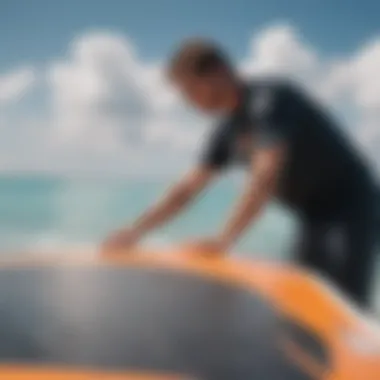

Taking care of a wing board is just like keeping a fine-tuned instrument in peak performance. Proper maintenance and care are pivotal not only for extending the lifespan of the board but also for ensuring it performs well when you're out there riding the waves. Water sports equipment, especially one like a wing board that faces the elements, needs special attention. So, let’s dive into the nitty-gritty of maintaining your gear, focusing on cleaning techniques and storage recommendations.
Cleaning Techniques
Cleaning your wingboard is essential after every use, especially if you've been in saltwater. Salt can corrode parts of your gear if left unattended. Here are a few effective cleaning techniques that will keep your board in tip-top shape:
- Fresh Water Rinse: After every session, grab a bucket of fresh water or find a hose. Rinse off all surfaces of your board to wash away salt and sand. It may seem simple, but this step is critical in preventing damage.
- Mild Soap Solution: Occasionally, using a mild non-abrasive soap can help tackle any stubborn grime. A soft sponge is your best friend here; scrub gently without overdoing it to avoid scratches.
- Drying: Use a soft cloth to dry your board thoroughly. Avoid leaving it to air dry in direct sunlight as this can cause materials to fade or warp.
- Check for Damage: While you're cleaning, take a minute to inspect your board for scratches, dents, or any signs of wear. Catching issues early can save a headache later.
"Proper care of your equipment is like investing in your next adventure; always pays off in the long run."
Storage Recommendations
Storing your wing board appropriately is just as important as cleaning it. Improper storage can lead to unnecessary wear and tear. Here are a few pointers to consider:
- Keep It Indoor: When not in use, store your wing board indoors. Direct exposure to the sun can degrade materials over time, making the board less reliable when it's time to hit the water.
- Use a Board Bag: If you're traveling or even just putting it away at home, a padded board bag offers the best protection. It cushions the board from bumps and stops dust or dirt from accumulating.
- Flat Position: Store your board flat. Avoid stacking it with other heavy items, as this could warp the shape. Lay it down in a cool, dry area.
- Remove Accessories: When storing for long periods, consider removing any attached accessories or gear. This will lighten the load and minimize stress on the attachment points.
By committing to regular cleaning and smart storage practices, your wing board will remain a trusty companion for years to come. Keeping it in excellent condition is not just about the performance; it feels good to ride a board that looks sleek and polished.
Future Prospects of Wing Boards
The realm of wing boards is on the cusp of remarkable evolution, presenting ample opportunities for enthusiasts and professionals alike. Understanding the future prospects of wing boards isn’t just an academic exercise; it’s about grasping the shifting tides in water sports that could redefine experiences on the water. These developments not only enhance the sport’s appeal but also ensure safety and sustainability for generations to come. As such, exploring what's to come in this area involves diving into emerging trends shaping the market and potential innovations that could change the game.
Emerging Trends
Several notable trends are surfacing in the world of wing boards, reflecting broader shifts within water sports. These trends include:
- Increased Accessibility: As manufacturers turn their focus to developing user-friendly designs, the barrier to entry for newcomers diminishes. This includes lighter materials and smaller sizes that cater to a wider range of skill levels.
- Sustainable Design: Environmental concerns are prompting brands to explore sustainable materials that don’t compromise performance. Options like recycled plastics and bio-resins are beginning to appear on the market, appealing to eco-conscious riders.
- Customization and Personalization: One size does not fit all in water sports, prompting a rise in customizable wing boards. Brands are offering options for riders to modify sizes, colors, and performance aspects, giving a unique touch to each board that aligns with personal styles and needs.
- Integration with Technology: Smart technology is increasingly integrated into equipment. For instance, some new models incorporate GPS tracking or performance monitoring capabilities, helping riders analyze their sessions and improve.
"The future of water sports is not just about performance—it's also about creating a community and fostering individual connections to the sport."
Potential Innovations
As we peer into the horizon of wing boarding, several innovations stand out, promising to revolutionize the experience on the water:
- Advanced Materials: Innovations in materials science may lead to the creation of wings that are not only lighter but also more durable. Think of composite fabrics that can withstand harsh conditions while maintaining flexibility and responsiveness.
- Augmented Reality (AR): Imagine putting on a pair of AR goggles that could overlay real-time performance statistics and conditions right on the water. This could allow riders to make instant changes to their approach based on environmental factors.
- Hydrodynamic Enhancements: Expect to see further refinements in design that optimize hydrodynamics, leading to faster speeds and improved maneuverability.
- Connected Gear: With the rise of the Internet of Things (IoT), we might see the arrival of highly connected gear that can communicate with one another. This might help in optimizing setups for safety and performance, fundamentally changing how riders interact with their equipment.
The future of wing boards is poised to draw in a wider audience while pushing the boundaries of performance. Kiteboarders, instructors, and enthusiasts should keep their ears to the ground, as the next leap forward could be just around the corner.
The End
The final section of this exploration into wing boards ties together the myriad elements discussed throughout the article. Understanding the importance of wing boards in the kiteboarding landscape offers key insights that potentiate the user experience for riders at any level. A multitude of considerations—ranging from design and functionality to safety and maintenance—affect how enthusiasts interact with this innovative gear.
Summative Insights
To distill the article’s core messages, wing boards are not just a passing trend; they signify a paradigm shift in how we approach water sports. The intersection of technology and design has ushered in a new era where riders can harness the wind and water with unprecedented efficiency.
- Versatile Applications: The adaptability of wing boards has broadened their reach beyond just kiteboarding. They bring opportunities for cross-disciplinary engagement with other water sports, such as stand-up paddleboarding and surfing.
- User-Centric Design: Innovations in materials and construction cater to various user needs, making these boards accessible. From lightweights for beginners to more robust builds for pros, there’s an option tailored for every kiteboarder.
- Safety and Maintenance: As emphasized in our preceding sections, proper care and safety gear remain paramount. Riders need to be mindful of the conditions and their equipment to ensure a safe and enjoyable experience.
By grasping these insights, readers can appreciate the strategic role of wing boards, not only as equipment but as an integral part of the larger kiteboarding community, affecting trends, preferences, and performance standards.
Final Thoughts on the Wing Board Experience
The journey with wing boards is one of continual learning and adaptation. While engaging in this sport, every rider gains knowledge regarding their craft, the equipment, and the environment around them.
- Connection to Nature: Riding on a wing board fosters a unique connection between an individual and the elements. Understanding how to read the wind and water can elevate one’s experience, connecting them deeply with the environment.
- Community Engagement: As the wing board becomes more popular, so too does the community surrounding it. Sharing experiences with fellow kiteboarders creates camaraderie, making the sport not just individualistic but a shared journey amongst adventurers.
- Forward-Thinking Spirit: The technology surrounding wing boards continues to evolve. Anticipating future developments can be just as exhilarating as riding. It opens doors for new enthusiasts and fosters a sense of excitement about what the future holds.
In summary, the wing board experience encapsulates not just a sport but a lifestyle—an adventure characterized by thrill, community, and a passion for discovery on the water.








